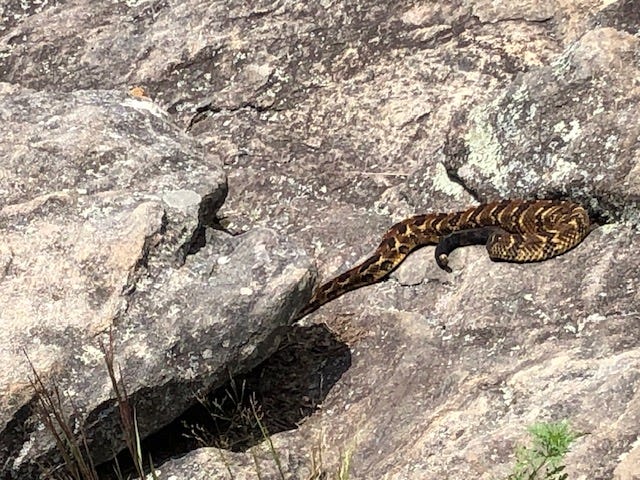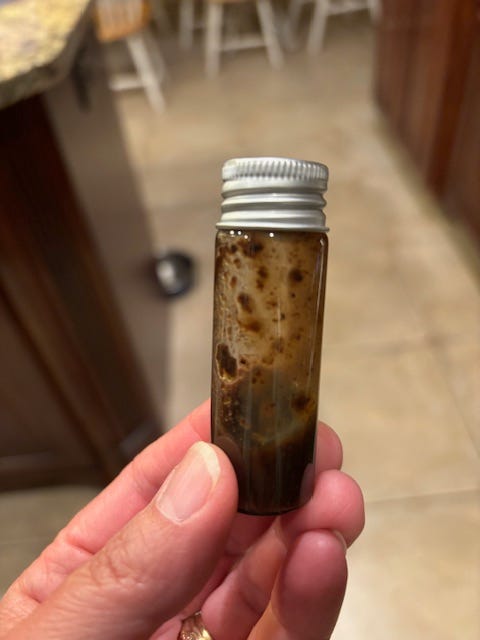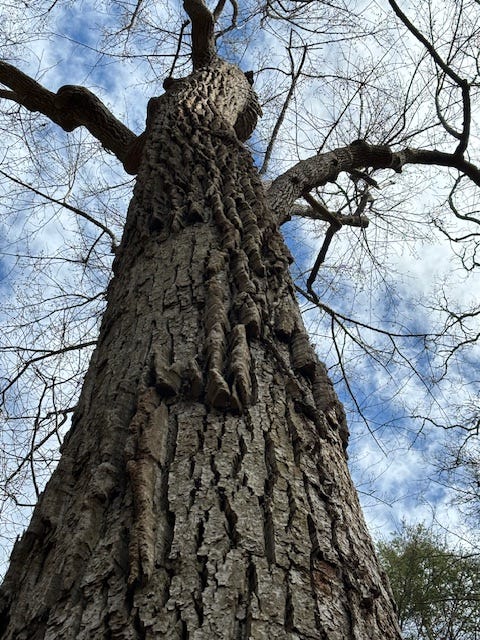Should you give your dog a rattlesnake vaccine?
Plus, an update on beavertail juice and how nature makes us happier and more generous…
It was after 10pm when I poked my head out the front door to see what was taking Andrew so long to walk the dog. Peering into the darkness, I saw a dimly silhouetted shape – arms out, a flailing snake on the end of a stick, and Toby excitedly circling. “Get the dog!” Andrew yelled as he turned toward me, and that’s when I saw the rattlesnake dangling from the end of his snake stick. It was the second rattlesnake in our front yard that week.
Only 4 months earlier, Toby had been bitten by a copperhead just feet from the garage. He’d gone to his favorite pee spot and BAM! The copperhead struck from beneath a pile of leaves. We rushed him to the vet, who was able to administer antivenom to control the swelling. He healed quickly, and actually would have been ok even without the antivenom, but the vet told us that if it had been a rattlesnake he would likely not have survived since their venom is 50 times more potent.
The rattlesnake scene above occurred this past October during a drought. After living at our house for 15 years, it was the very first time we’d seen a rattlesnake beside the house. That week we saw two big ones in three days. It may be that the dry spell was driving them nearer to the creek, where their prey was. Or it may have been a particularly aggressive mating season. Either way, we started getting very nervous for Toby.
Andrew did a little research and found that some vets will administer a rattlesnake vaccine to dogs. It won’t make the dog immune to the snake’s venom, but it will buy you time to get them to the nearest animal hospital. Now that the weather’s getting warmer and snakes are on the move, we decided to get him vaccinated, but we couldn’t find a vet near us who carried it. Even the state university veterinary school didn’t have it. Only a vet in nearby South Carolina could order it. But then a good friend shared an article with me stating that veterinary experts don’t recommend the rattlesnake vaccine. Why not? What should we do with Toby?
Should you give your dog a rattlesnake vaccine?
It turns out there is only one company that manufactures this vaccine: Red Rock Biologics. The vaccine is designed to protect against western diamondback rattlesnakes, which are found in the American Southwest. However, all rattlesnake venoms are not the same – western diamondbacks contain a venom that’s primarily hemotoxic, meaning it affects the blood vessels and the heart. It also contains other toxins that attack the muscles. On the other hand, the venom of the timber rattlesnakes we have in the southeastern U.S. can either be neurotoxic or hemorrhagic, depending on where you find them, or a combination of the two where they intermix. In other words, a vaccine for a western diamondback may not have the same effect on a dog that’s bitten by a timber rattlesnake.
The American Animal Hospital Association issued a statement about rattlesnake vaccines and cautioned veterinarians that the vaccine may not cross-protect against snakes other than the western diamondback. They also point out there is no published peer-reviewed data on the efficacy of the vaccine. A study was published using mice that were injected with high amounts of the vaccine (50-1500 times that recommended for dogs) but while many of the mice survived, some of them had to be euthanized earlier than non-vaccinated mice. The vaccine offered “limited” protection against venom from snakes other than the western diamondback.
One big concern? Some dogs who received the vaccine have gone into anaphylactic shock once they’ve been bitten by a rattlesnake. The researchers believe the vaccine sensitized the dogs to the venom, setting them up for an allergic reaction once they got bitten by an actual snake.
All of this had me thinking that the potential negatives of a rattlesnake vaccine might outweigh the positives. The final nail in the coffin was reading a study about 272 cases of dogs who were bitten by rattlesnakes in Arizona. Only eight of those dogs died, mostly those who were older than 10 years or had an extended time between being bitten and getting treatment. Some of these dogs had been vaccinated, but researchers found no evidence that made a difference. The authors stated, “Vaccination for protection of the general canine population from rattlesnake envenomation cannot be recommended by these authors.”
As disappointing as it is not to have a vaccine as an insurance policy, it is somewhat of a relief to see that a rattlesnake bite is not an automatic death sentence for a dog. So much depends on the size of the dog and the amount of venom they receive – and we do know that snakes can control their venom injections, particularly if they’re older and more experienced.
I figured if I was going to do the research about this question for Toby, I should share it with all of you as a Public Service Announcement. But I’d love to know if any of you have any experience with a snake vaccine? Please leave a comment if you do, or if you have thoughts about the vaccine.
In other news… about beavertail juice…
You know you have good friends when one carts around a vial of juice from a beaver’s anal glands for weeks until the next time he sees you. My friend Payton read my article about Why beavers need to build dams, in which I mentioned that
beavers produce a dark, thick liquid from a sac underneath their tail that’s used to mark their territory or to attract mates. It’s called castoreum. Somehow, humans discovered this molasses-like fluid is… delicious?
Payton had a vial of the stuff to give me so I could smell it for myself. I am here to tell you – that stuff is surprisingly good-smelling, and not at all what you would expect, knowing from whence it came. It smells like a combination of vanilla, anise oil, and mint. I’d definitely eat some castoreum candy, as long as it didn’t look like the stuff in the vial:
Book review:
I first heard about The Nature Fix by Florence Williams in
’s newsletter Everything Is Amazing. The subtitle of this book is Why nature makes us happier, healthier, and more creative and that’s it in a nutshell. This is a very readable popular science book that confirms much of what we understand intuitively: nature is good for us. And we’ve gotten too far away from it in our modern world. Today’s children spend half as much time outside as their parents and up to 7 hours a day on screens. Not to mention the time on screens at school (as a part-time teacher I can confirm – it’s a lot).Nature, it turns out, has been scientifically proven to help us destress and achieve brain rest. Some of this is from the aerosols released by trees, which can instantly lower your heart rate by four points, lower cortisol levels, and reduce symptoms of asthma after just 15-20 minutes. The lack of stressful city noises is another reason nature is calming, but according to the National Park Service, “83% of the land in the lower forty-eight states sits within 3,500 feet of a road.” Williams states another shocking statistic: “the entire continental United States has fewer than a dozen sites where you can’t hear human-made noise for at least fifteen minutes at dawn.” Even if you live with lots of human noise, you can reap the benefits of nature by making sure you hear the trifecta of nature sounds each day: wind, water, and birds. In hospitals, patients with views of the outdoors needed fewer days to recover in the hospital and less pain meds. Studies even show that people in rooms with potted plants are more generous than those without plants.
Granted, there are some folks who aren’t fans of nature. They may enjoy a nice view, but may feel like Woody Allen: “I love nature, I just don’t want to get any of it on me.” For those folks, it’s still very beneficial to view nature through a windshield or even computer screen.
Being outdoors lowers risks of cardiovascular disease. For children, it reduces symptoms of ADHD threefold. The awe we feel when viewing an enormous mountain range or thunderous waterfall has actually been shown to boost our immune systems.
It seems there’s not really a downside to being outdoors (other than the likelihood of getting some of it on you). If you’re a fan of being outdoors and want to find out how it’s helping you (or if you’re suffering from health concerns of the physical or mental kind), I can’t recommend this book enough.
Nature is “a place where birds fly around uncooked.” ~ Oscar Wilde










Thank you so much for this very informative article. As a dog owner it is always on my mind.
No dogs to worry about, but not too many Rattlers in Portland either!